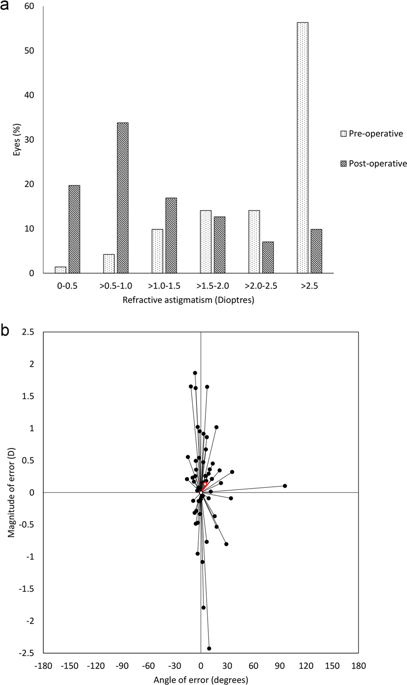Our official English website, www.x-mol.net, welcomes your
feedback! (Note: you will need to create a separate account there.)
Visual and autorefraction outcomes following toric intraocular lens insertion without calculation of posterior corneal astigmatism in the UK National Health Service
Eye ( IF 2.8 ) Pub Date : 2020-01-29 , DOI: 10.1038/s41433-020-0779-2 Alasdair Warwick 1 , Alastair Porteous 1 , Valerie P J Saw 1, 2
Eye ( IF 2.8 ) Pub Date : 2020-01-29 , DOI: 10.1038/s41433-020-0779-2 Alasdair Warwick 1 , Alastair Porteous 1 , Valerie P J Saw 1, 2
Affiliation

|
Objective To ascertain visual and refractive outcomes following toric intraocular lens (IOL) implantation in the UK National Health Service (NHS) without posterior corneal astigmatism calculation, with multiple surgeons of different grades, pooled input and output pathways and autorefraction as the refractive outcome measure. Methods Preoperative and 1-month post-operative data were analysed retrospectively in 114 eyes (95 patients) receiving a toric IOL between 2014 and 2016 at Imperial College NHS Trust. Preoperative keratometric astigmatism was ≥2 dioptres (D). Results Mean preoperative best-corrected visual acuity (BCVA) was 0.50 logMAR (±0.46), improving to a mean uncorrected VA (UCVA) of 0.35 logMAR (±0.36) postoperatively ( p < 0.001) with 65% of eyes attaining a UCVA ≤ 0.30 logMAR. Excluding 33 eyes with pre-existing visual comorbidities and one targeting monovision, mean post-operative UCVA was 0.24 logMAR (±0.29) ( p < 0.001), and 85% had UCVA ≤ 0.30 logMAR, 62% UCVA ≤ 0.20 logMAR. Mean refractive astigmatism improved from 3.04 D (±1.46) to 1.36 D (±1.13) ( p < 0.001). In total, 52% of eyes had post-operative refractive astigmatism ≤1.00 D. The Alpins correction index was 1.05 (±0.22), indicating a tendency to overcorrect. Toric IOL misalignment was noted in two eyes, and two cases of posterior capsule rupture were converted to a non-toric IOL. Conclusions Visual outcomes of toric IOL implantation in our pooled pathway are comparable to single-surgeon case series where posterior corneal astigmatism has not been accounted for. However, with 1-month post-operative autorefraction, only 52% of eyes had ≤1 D refractive astigmatism, which is lower than previously published series, but may be standard for 1-month autorefraction outcomes.
中文翻译:

英国国民健康服务中未计算后角膜散光的植入环面人工晶状体后的视觉和自验光结果
目的 确定英国国民健康服务 (NHS) 植入环面人工晶状体 (IOL) 后的视力和屈光结果,无需计算后角膜散光,使用不同级别的多位外科医生、汇集输入和输出通路以及自验光作为屈光结果测量。方法 回顾性分析 2014 年至 2016 年在帝国理工学院 NHS 信托机构接受环面人工晶状体的 114 只眼(95 名患者)的术前和术后 1 个月的数据。术前角膜曲率散光≥2屈光度(D)。结果 术前平均最佳矫正视力 (BCVA) 为 0.50 logMAR (±0.46),术后平均未矫正视力 (UCVA) 提高至 0.35 logMAR (±0.36) (p < 0.001),65% 的眼睛达到 UCVA ≤ 0.30 logMAR。排除 33 只眼有既往视力合并症和 1 只靶向单眼,术后平均 UCVA 为 0.24 logMAR (±0.29) (p < 0.001),85% 的 UCVA ≤ 0.30 logMAR,62% UCVA ≤ 0.20 logMAR。平均屈光散光从 3.04 D (±1.46) 改善到 1.36 D (±1.13) ( p < 0.001)。总共有 52% 的眼睛术后屈光散光≤1.00 D。Alpins 矫正指数为 1.05 (±0.22),表明存在过度矫正的趋势。两只眼观察到环面人工晶状体错位,两例后囊膜破裂转为非环面人工晶状体。结论 在我们的合并路径中植入环面人工晶状体的视觉结果与未考虑后角膜散光的单一外科医生病例系列相当。然而,术后 1 个月的自动验光,
更新日期:2020-01-29
中文翻译:

英国国民健康服务中未计算后角膜散光的植入环面人工晶状体后的视觉和自验光结果
目的 确定英国国民健康服务 (NHS) 植入环面人工晶状体 (IOL) 后的视力和屈光结果,无需计算后角膜散光,使用不同级别的多位外科医生、汇集输入和输出通路以及自验光作为屈光结果测量。方法 回顾性分析 2014 年至 2016 年在帝国理工学院 NHS 信托机构接受环面人工晶状体的 114 只眼(95 名患者)的术前和术后 1 个月的数据。术前角膜曲率散光≥2屈光度(D)。结果 术前平均最佳矫正视力 (BCVA) 为 0.50 logMAR (±0.46),术后平均未矫正视力 (UCVA) 提高至 0.35 logMAR (±0.36) (p < 0.001),65% 的眼睛达到 UCVA ≤ 0.30 logMAR。排除 33 只眼有既往视力合并症和 1 只靶向单眼,术后平均 UCVA 为 0.24 logMAR (±0.29) (p < 0.001),85% 的 UCVA ≤ 0.30 logMAR,62% UCVA ≤ 0.20 logMAR。平均屈光散光从 3.04 D (±1.46) 改善到 1.36 D (±1.13) ( p < 0.001)。总共有 52% 的眼睛术后屈光散光≤1.00 D。Alpins 矫正指数为 1.05 (±0.22),表明存在过度矫正的趋势。两只眼观察到环面人工晶状体错位,两例后囊膜破裂转为非环面人工晶状体。结论 在我们的合并路径中植入环面人工晶状体的视觉结果与未考虑后角膜散光的单一外科医生病例系列相当。然而,术后 1 个月的自动验光,









































 京公网安备 11010802027423号
京公网安备 11010802027423号